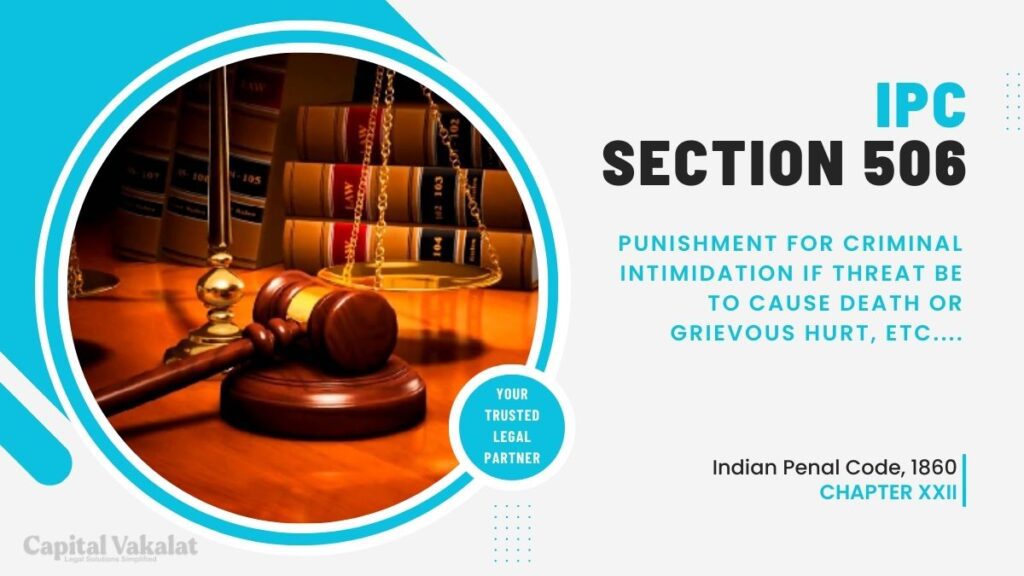The Indian Penal Code (IPC) is a comprehensive legal framework that addresses various offenses, and within its provisions lies Section 506, specifically dealing with the punishment for criminal intimidation.

This article explores the nuances of Section 506 IPC, focusing on instances where the threat involves the infliction of death or grievous hurt.
Introduction to Section 506 IPC
Definition of Criminal Intimidation
Criminal intimidation refers to the act of causing fear of harm or threat to a person or property. Section 506 of the IPC pertains to cases where the threat extends to causing death or grievous hurt, adding an extra layer of severity to the offense.
Significance of Section 506 IPC
Understanding the significance of Section 506 IPC is crucial in comprehending the legal consequences for those found guilty of criminal intimidation leading to potential harm.
The Scope of Punishment
Threats to Cause Death
Examining cases where the threat involves causing death unveils the gravity of the offense and the corresponding legal repercussions. This section delves into the specifics of such threats and their implications.
Threats to Cause Grievous Hurt
Similarly, threats to cause grievous hurt demand a closer look at the severity of the intimidation. Section 506 IPC outlines the punishment for individuals who employ such threats, exploring the nuances of the legal consequences.
Understanding Criminal Intimidation in Legal Terms
Elements of Criminal Intimidation
To understand the legal intricacies, one must grasp the essential elements constituting criminal intimidation. This section breaks down the components that make an act fall within the purview of Section 506 IPC.
Intent and Mens Rea
Establishing criminal intent (mens rea) is paramount in cases of criminal intimidation. Delving into the psychological aspects, this section explores how the law interprets and proves the intent behind threatening behavior.
Landmark Cases and Precedents
Notable Cases Involving Section 506 IPC
Examining landmark cases provides insight into how courts have interpreted and applied Section 506 IPC in the past. This section highlights cases that have set legal precedents.
Court Interpretations and Rulings
Understanding court interpretations and rulings adds depth to the discussion, shedding light on how the judiciary has shaped the application of Section 506 IPC over time.
Importance of Section 506 IPC in Contemporary Society
Deterrence and Crime Prevention
Section 506 IPC plays a crucial role in deterring potential offenders and preventing crimes. This section explores the broader societal impact and the role of this legal provision in maintaining public order.
Protection of Individual Rights
Examining how Section 506 IPC safeguards individual rights emphasizes its role in preserving the fundamental liberties of citizens. This section discusses the balance between individual rights and public safety.
Distinctions Between Criminal Intimidation and Other Offenses
Comparison with Assault and Threatening Behaviors
Distinguishing criminal intimidation from related offenses, such as assault and threatening behaviors, is essential for a nuanced understanding. This section explores the fine lines that differentiate these offenses.
Differentiating from Cyber Threats
In the digital age, the distinction between physical and virtual threats is crucial. This section discusses how Section 506 IPC addresses and distinguishes cyber threats from traditional forms of criminal intimidation.
Legal Consequences and Penalties
Imprisonment and Fine Provisions
Section 506 IPC specifies the penalties for those found guilty of criminal intimidation. This section outlines the imprisonment and fine provisions, providing clarity on the legal consequences.
Factors Influencing Sentencing
Understanding the factors that influence sentencing decisions is crucial in predicting the outcomes of cases under Section 506 IPC. This section explores the variables that courts consider during sentencing.
Critiques and Controversies Surrounding Section 506 IPC
Debate on Severity of Punishment
Examining debates surrounding the severity of punishment under Section 506 IPC offers a balanced perspective. This section delves into the arguments for and against the current legal provisions.
Calls for Legal Reforms
As with any legal provision, Section 506 IPC has faced calls for reforms. This section discusses the ongoing discourse on potential changes to better address evolving societal needs.
Addressing Challenges in Enforcement
Investigative Difficulties
Enforcing Section 506 IPC poses certain challenges for law enforcement agencies. This section explores the difficulties investigators face and potential solutions to enhance enforcement.
Challenges in Establishing Mens Rea
Establishing mens rea in cases of criminal intimidation can be complex. This section discusses the challenges associated with proving intent and suggests improvements to streamline legal processes.
Conclusion
Recapitulation of Key Points
In conclusion, Section 506 IPC serves as a vital tool in addressing criminal intimidation leading to threats of death or grievous hurt. This article has explored its significance, legal consequences, and societal impact, providing a comprehensive understanding of its role in the Indian legal system.
Emphasizing the Role of Section 506 IPC in Upholding Justice
As we navigate the complexities of legal frameworks, Section 506 IPC stands as a cornerstone in upholding justice, striking a delicate balance between individual rights and the collective safety of society.
Frequently Asked Questions
How long can someone be imprisoned under Section 506 IPC for threatening to cause death?
The duration of imprisonment under Section 506 IPC varies depending on factors such as the severity of the threat and the presence of any aggravating circumstances.
Are there any defenses available for individuals accused under Section 506 IPC?
Yes, defenses such as lack of intent, mistaken identity, or insufficient evidence can be used in cases under Section 506 IPC.
Is Section 506 IPC applicable only to physical threats, or does it cover virtual threats as well?
Section 506 IPC is not limited to physical threats; it can also be applied to virtual or cyber threats that cause fear of harm.
Are there ongoing efforts to amend Section 506 IPC to address contemporary challenges?
Yes, there have been discussions and proposals for legal reforms to address evolving challenges and ensure the continued relevance of Section 506 IPC.